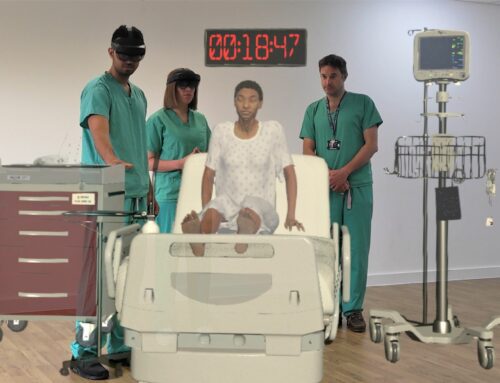By Tim Gillis, Director of Business Development for Healthcare Solutions at Stratix
Virtual care is having a positive impact on healthcare, and it’s here to stay. A McKinsey report revealed that 11% of Americans used virtual care in 2019, and in 2020, 76% of patients said they were highly or moderately likely to use healthcare technologies. More patients have shifted to a positive view of virtual healthcare since the COVID-19 pandemic began. As virtual visits increase significantly, patients have reported an 86% satisfaction rate with their experience, and healthcare providers have reported reduced hospital readmissions and greater overall efficiencies. Overall, virtual care seems to be a win-win, and the demand is growing.
Telehealth Goes Mainstream
Telehealth has been transformed since COVID-19, and technology will continue to play a crucial role. Although telehealth existed before the pandemic, the need for virtual care has been catalyzed by the addition of the Centers for Medicare and Medicaid Services (CMS) releasing new reimbursement CPT codes for providers. With healthcare providers now conducting 50 to 175 times the number of telehealth visits than they did before the pandemic, it seems daunting to keep up with this surge while maintaining the same quality care level that all patients need. This is where mobile technologies and remote patient monitoring come into play to provide even more confidence in virtual healthcare.
The Proven Catalyst for Improving Virtual Care
Mobile technology enables patients the ability to video conference with their provider instead of going into hospitals for a health check-up. This saves time for both the patient and care teams, keeping healthy patients healthy and high-risk patients safe at home. This was crucial during the early days of the pandemic but is also useful for patients with chronic diseases or seniors and people with disabilities who are safer staying away from a facility.
Mobile video conferencing has made the demand for telehealth services more manageable for doctors because virtual appointments save time. Remote patient monitoring (RPM) makes maintaining the quality of care even easier by enabling healthcare providers to monitor and coordinate care while managing the patient’s health history. Healthcare systems have access to patient’s progress in real-time, whether the patient is home or in the health system. This allows the care teams to be agile during daily case management or if the patient requires triage.
Remote Patient Monitoring Drives Better Outcomes
Remote patient monitoring is useful for patients with chronic illnesses like diabetes, heart disease, and palliative care but is also helpful for proactive consultations, check-ins and monitoring patients post-operation. Devices, smartphone apps, wearables like smartwatches, and Bluetooth biometric devices like pulse oximeters help monitor glucose levels, track dietary information, check blood pressure, heart rate, pulse, medication levels and more, without the patient leaving home. With doctors and visiting nurses able to track a patient’s biometric data essentially 24/7, healthcare providers have more information to provide the best care at the right time, reducing hospitalization rates by 40%.
With access to this information, healthcare workers can provide better recommendations, communicate with other specialists easier and faster, and prevent any issues that otherwise might be missed. Additionally, healthcare providers can do this from any location and even monitor procedures, bringing quality care to patients who may not be geographically near the right specialists. Patients can also receive second opinions virtually with access to more specialists and provide their health data in real-time.
Supporting Frontline Workers are Key to a Healthy Future
Remote patient monitoring and mobile technology proved to be especially crucial during the early days of the COVID-19 pandemic. Doctors needed to see accurate data on sick patients in order to determine the best next steps. Organizations that had already armed their nurses, doctors, and other practitioners with mobile technologies like smartphones and tablets were prepared to provide quality care to patients while maintaining safety and productivity levels for their staff. Now, as the demand for telehealth services continues to grow and scale globally, frontline workers, nurses, and healthcare practitioners want and need access to these progressive technologies to provide the best possible care for patients and improve efficiencies in their facilities.
While healthcare might be the most important vertical to adopt mobile technologies since it can help to prevent deaths and prolong or improve lives, our recent VDC survey results show that most IT departments are not prepared to provide these tools at scale to their healthcare teams. Of the respondents in the survey, 33.8% of healthcare frontline workers said that the capabilities of their internal IT teams were barriers to adapting the ways in which it engages and does business with its patients in response to COVID-19. Further, 27.7% of respondents reported that their IT service partners did not have the capabilities to provide this, or there was a lack of IT services available to scale access to mobile technology. Frontline workers are the key to a healthier future, but they need to be provided with the tools, services and support to protect themselves and provide the best care for patients.
Caring for the Most Vulnerable
Home healthcare agencies offer their patients a greater benefit from technologies using virtual care and remote patient monitoring. Mobile devices allow visiting nurses to provide timely and accurate documentation, receive visibility into necessary data, and ultimately preventive care, leading to improved patient outcomes. Rehospitalizations and ED readmissions occur due to a lack of communication or transparency about a patient’s condition, but access to real-time data can help prevent this. Visiting nurses can better track post-surgical recoveries and diabetes patients, prevent ER readmissions, improve compliance, and streamline reimbursement for these services. Seniors and disabled patients can live at home longer, reduce their health care costs, and improve their quality of life. Visiting nurses are demanding mobile tools to access referrals, care teams, manage workflows and deliver accurate care during that visit.
To provide the best outcomes for patients, healthcare providers will need to leverage the right technologies to offer telehealth services quickly and securely. The ability to provide this to patients during the beginning of COVID-19 proved to be extremely helpful. Medicare has increased dramatically to offer telehealth services to patients, and this investment will continue to grow as demand and adoption increase.
About the Author
 Tim Gillis is Director of Business Development for Healthcare Solutions at Stratix. He brings 18 years managing mobility projects in Healthcare Information Technology and Home Health. Tim has delivered various solutions from managing wearable sensors in Class II medical devices to Home Health EMR solutions and services supporting software platform solution such as Homecare Homebase, Medtronic, Epic and Vivify.
Tim Gillis is Director of Business Development for Healthcare Solutions at Stratix. He brings 18 years managing mobility projects in Healthcare Information Technology and Home Health. Tim has delivered various solutions from managing wearable sensors in Class II medical devices to Home Health EMR solutions and services supporting software platform solution such as Homecare Homebase, Medtronic, Epic and Vivify.












